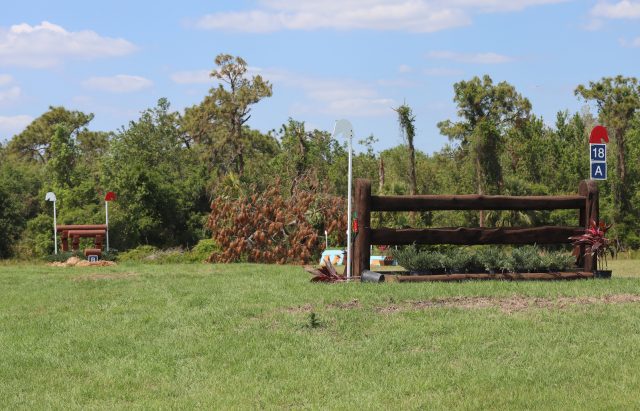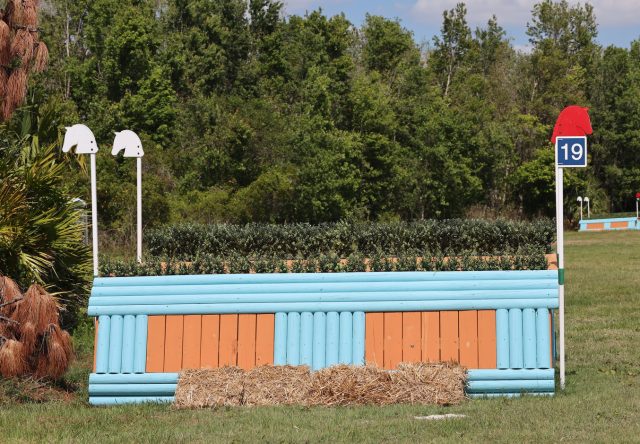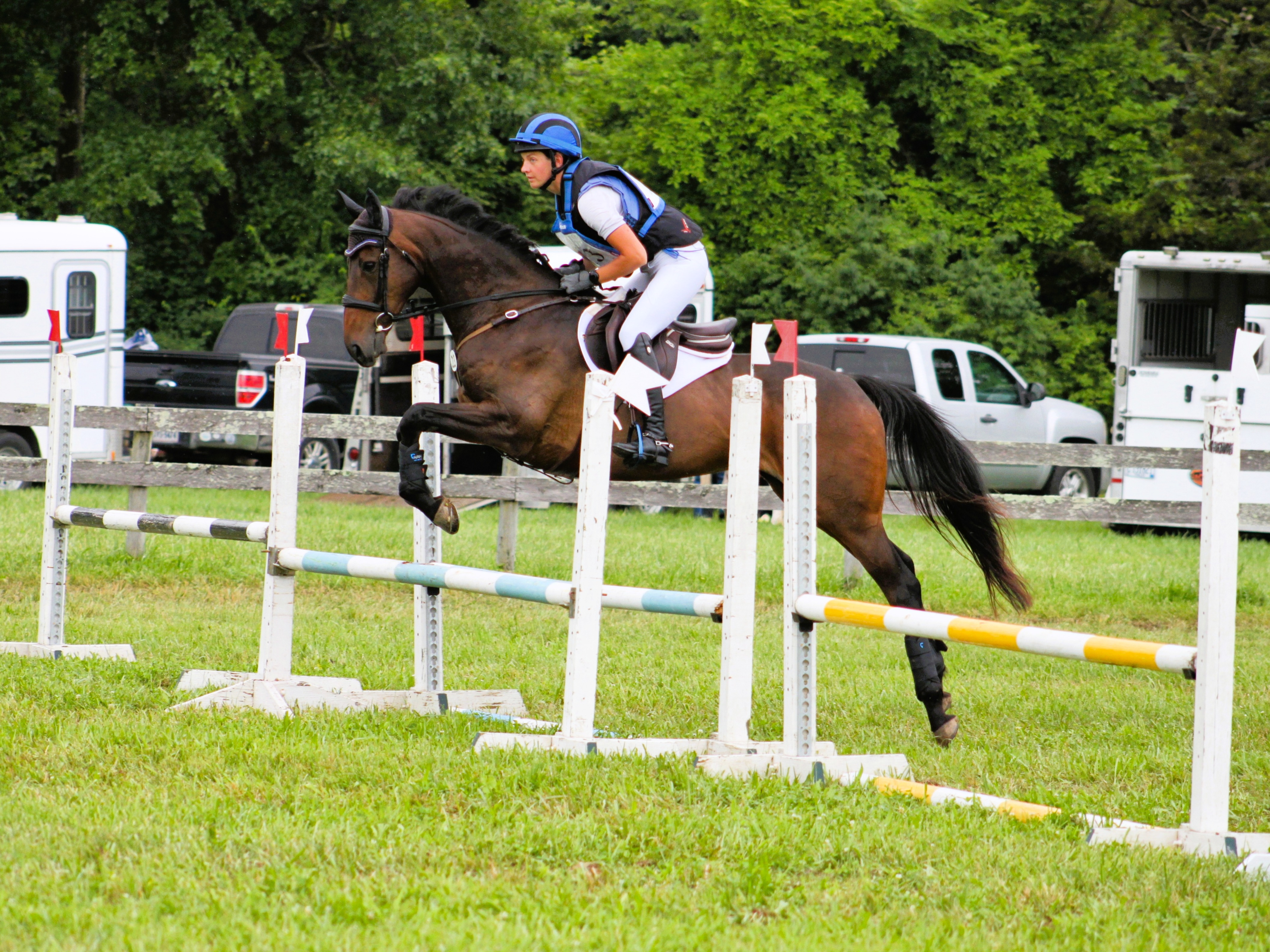
Hey! Recognise these guys? That’s Tom McEwen and Toledo de Kerser! You probably really like them! You also won’t read about them in this report because they withdrew so quickly after dressage that I couldn’t even tell you what place they were in at the time, let alone where they’d have been now. Anyway they scored a 27.6 if that’s information that you’re into. Photo by Tilly Berendt.
I’ve been at this game for a fair while now, but even so, eventing still finds ways to treat me — and, well, all of us — to entirely new experiences. The absolute onslaught of appalling weather that the Eventing Spring Carnival at Thoresby Park has been besieged by isn’t exactly a novel experience; we’re in England at the cusp of spring, after all, and if us Brits do one thing well, it’s rain (and whinging, also, probably). Nor is mud a new thing; nor is the debate about whether or not to run or save horses for another day. We’re used to seeing plenty of withdrawals, too; I’ve reported on events where we’ve lost half a class before cross-country because the ground is too wet, or too dry, or too something else entirely — but even I’ve never spent a morning trying to report on dressage when there’s effectively an entire judging break between every single test. That’s no exaggeration: yesterday, as the rain hammered away at us, the warm-up ring was chock-full of horses at all times and both the three- and four-star arenas were abuzz with activity all through the day, without so much as a lunch break to be had from 8.00 a.m. ’til 5.00 p.m. But today? When I arrived at just past 8, there was one lone horse pootling around the arena, and no one to be seen in the warm-up. And that’s how it continued on for hours: there’d be a long span of nothingness, then one horse would appear, warm up on its own, do its test on its own, and leave us all in silence with nothing at all to look at once again. It was a little bit like eventing after the apocalypse, which isn’t actually a totally far-fetched idea, because I’m beginning to think that those of us mad enough to love this sport really would keep doing it even if life as we know it stopped existing entirely.

Imogen Murray and Shannondale Vintage take a spin around the Open Intermediate at the tail end of a day of cross-country. Photo by Tilly Berendt.
But then you’d step outside of the walled garden in which those two dressage rings are ensconced, and things felt a little different. Both the remaining OI sections, plus the CCI3*-S, tackled showjumping (mercifully moved out of the main arena, which has now been relegated to a country fair activity area) and cross-country, and though they suffered an eye-watering number of withdrawals, too, there actually was some action going on. Not loads, mind you: at one point in the first OI section, just one horse trundled by over the course of nearly an hour, but it was happening. There may have been just ten horses left to run in one OI and thirteen in the other, but that still counts, right? And those who did run actually largely did so sans drama, albeit slowly. Despite yesterday’s drama with those deep arenas and that seriously tough footing in the showjumping, the cross-country — or at least two-thirds of it — held up remarkably well, helped along by a crisp, dreary, but almost entirely dry day. (And, actually, we did have 65 horses go cross-country in the CCI3*-S, lest I misrepresent this as a day when just a small handful of horses tested that theory.)
Not that anyone ever regrets withdrawing a horse, for what it’s worth, but for those who truly need this run — the ones who have a five-star looming; the ones who have seen every single previous intended run cancelled — it was heartening. Will anyone run quickly tomorrow? It’s hugely unlikely. Will our original start list of 148 CCI4*-S competitors be cut in half? Almost certainly — as of right now, it’s down to 78, and we’re sure to see plenty more riders who are staying simply to log a showjumping round and call it a day. But right now, the show looks like it’s actually going to go on, and frankly, kudos must go to everyone involved; the team at BEDE Events, who have been doing no less than the best they can after being a truly crap hand, of course, but also the riders, and the owners, and the grooms who have put in hours of deliberation to make the best decisions they can for their horses, whether that’s to run or to withdraw. That Thoresby has been a bit of a stressful situation so far isn’t anyone’s fault but the weather’s (and I guess, by that token, we could argue we’re all to blame for being a bit crap at recycling, for booking long haul flights, and for not burning massive corporations to the ground, but that’s another rant for another day. Hey, did you know this has been the wettest March recorded in the UK in 40 years? We all certainly do!)
In any case, while the CCI4*-S worked its way through a long final day of dressage that could have been a quick matinee performance of dressage, really, and while the three-star and Intermediates cracked on with all their bits and bobs outside, there have been plenty of changes in the works to ensure that whatever we wake up to tomorrow, we’ve got the best of it. Now that the main arena has been well and truly canned off, showjumping will relocate up near the lorry park to an untouched field that should have housed the cancelled Novice dressage tests, and continued work is being done on restoring the ground on cross-country where it’s needed, with take-offs and landings being reinforced with stone. I suspect we’ll all be glad for a duvet day of some description on Monday, but for now, we have something to crack on with. That’s something, at least — even if we do have to forfeit seeing some of the super horses we’d hoped to see as a result of all those understandable withdrawals.
Among them? A number of the horses formerly in the top ten, including yesterday’s third-placed Tom McEwen and JL Dublin, and overnight leaders Laura Collett and London 52. That means that overnight runners-up Yasmin Ingham and Banzai du Loir now lead on their score of 25.4 as they face the tricky decision of whether or not to run in what is the horse’s last — and, actually, first — prep run ahead of Kentucky.

Emily King and Valmy Biats. Photo by Tilly Berendt.
Emily King slots into overnight second place with Valmy Biats, who she co-owns with breeder Philippe Brivois, Jacquie and Jeremy Shere, and the Event Horse Owners Syndicate group, which provides membership-based microsyndicate subscriptions to fans of the sport. They were out in force to support ‘their’ horse and rider, who were among the small handful of competitors to come forward for today’s second half of the first phase in this class — and their round of enthusiastic applause upon completion of the test was the first we’ve heard here at Thoresby. (Fortunately, they’re all very nice people, so they stuck around to cheer on the sparse few subsequent competitors, too – which certainly brightened up the eerily quiet walled garden.)
There was enough to cheer about, too: Badminton-bound Emily and Valmy earned themselves a 26.8 with a polished, professional test and no visible issues with the ground — though, as Emily explains, “he lives in the field literally the whole time, so he’s used to it!”
Even for horses who are confident on tricky ground, though, there’s the fine art of getting the warm-up right that needs to be negotiated first, and Emily’s one frustration following her ride was a niggling feeling that she’d slightly overcooked it.
“It was a fine balance, because you want them to get used to it, but it’s also tiring for them — it’s like working in sinking sand,” she explains. “But I was really pleased with him; he’s getting so much more chilled and rideable. I didn’t go for it [in the extensions] because I didn’t want to risk him losing his balance and make a mistake, so I was purposefully a bit more guarded in there than usual. Actually, he can be a bit of a hothead in his first tests of the year, so just for him to go in and be so calm was the main thing.”

Sarah Bullimore and Corouet. Photo by Tilly Berendt.
Sarah Bullimore‘s tiny — and rather fresh — European bronze medallist Corouet takes fourth place, just behind Emilie Chandler and Gortfadda Diamond, who remain in podium position two days after their test. Though ‘Elfie’, who Sarah bred herself from former team ride Lilly Corinne, had plenty of pep in his step before and after his test, he executed a professional, mature performance in the ring to make the best of the holding conditions and earn himself a 27.3.
Like all of the elite first-phase performers we’ve seen this week, his result doesn’t rival his very best at the level (a 19.6, for what it’s worth, earned at Burgham in 2021) — but conditions like these require slightly more conservative riding, with an aim to produce a correct, positive test, rather than one that risks a wobble or a loss of confidence in a patch of questionable ground. With that in mind, Sarah was pleased with the work her stable star produced.
“He stayed with me, though I did slightly over prepare for the second flying change, and he had a bit of a skip,” she says. “That’s normally a highlight, but actually, for him to stay with me and not try to be naughty was lovely.”
Sarah and Elfie are among those lucky few pairs to have already managed a couple of runs this season, though even this, Sarah explains, requires a bit of finely-honed balancing: “The more runs you get in, the faster he gets — but on the flip side, the more runs he has, the feistier he is,” she laughs. “But then, in order to know I have control, I have to run — so it’s all a work in progress, but he was lovely at Poplar and while he was a little feistier at Lincoln, he finished second because a lot of people got stuck in the mud.”
That’s not an issue for 15.2hh, finely-built Elfie: “You’d think being so little, he’d get stuck in the mud – but actually, it helps me ride him, so it’s probably a good thing,” she says with a smile.
Ros Canter rounds out the top five with her 2022 Badminton runner-up Lordships Graffalo, who posted a 27.4, and she also sits sixth overnight on Pencos Crown Jewel, who earned a 28.3 for her sweet test yesterday.

William Fox-Pitt and Grafennacht. Photo by Tilly Berendt.
The only other new entrant to the top ten from today’s competition is William Fox-Pitt with the classy Graffenacht, who returns to FEI competition after sitting out the 2022 season.
“She’s feeling great after her unexplained sabbatical last year, which we hope time will have sorted,” says William, who currently sits seventh on 29.9 with the eleven-year-old 2021 Boekelo runner-up. This week will ostensibly be a prep run for either Kentucky or Badminton — if he decides to run. That decision will also impact which of those two entries he’ll keep, and which he’ll discard. But even getting this far, he explains, has been something of a bureaucratic process after her time off.
“She has to have a four-star run because she needs the qualification [to go five-star] — but actually, she wasn’t initially allowed to come here, to be honest,” he explains. “Under the new rules, she’d have had to have done a three-star to do a four-star to do a five-star, and there wasn’t time, so British Eventing had to write a letter to the FEI applying for an exemption to be able to run here, which they granted.”
Should he decide not to run the mare, though, there’s another option: “She could go to the four-star at Burnham Market in two weeks, but they fly to Kentucky so soon after that it would be unfair to do that — so if she has to go to Burnham Market, she’ll go on to Badminton. I don’t really have a preference, but having had a year off, Kentucky might be a fairer question. It’s just a more friendly occasion; it was bloody serious the last time I went there, but it’s also a bit more on a plate for them, whereas at Badminton, you get Eric Winter fences — you have to kind of shut your eyes and hope a bit!”
Whichever way he decides to structure the rest of the mare’s weekend, though, he’s been infused with a burst of optimism after expecting a horror show at the dressage, and finding — well, perhaps something more like ‘good hunting ground’, as Nicola Wilson later referred to it with a grin.
“To be honest, [the dressage ring] is amazing compared to what I was expecting,” William says. “I was expecting this” — he gestures towards yesterday’s warm-up ring, which resembles nothing so much as a freshly ploughed field — “but actually, although it’s muddy and mucky, it hasn’t gone pothole-y. They can work in it, and she couldn’t care less; she’s a tough old wench!”

The top ten going into the two-phase final day of Thoresby in the Grantham Cup CCI4*-S.
Piggy March retains her lead from yesterday in the CCI4*-S P section with the relatively inexperienced Brookfield Cavalier Cruise, who sits nearly two points ahead of second-placed Harry Meade and Red Kite on a score of 25.4 to Harry’s 27.3. Yesterday’s second- and third-placed competitors, Flora Harris and Monbeg Alcatraz and Edie Campbell and Fireball F, now sit third and fourth respectively. This division, which is for lower-ranked horses, is chock-full of up-and-coming, inexperienced horses and some new faces among the riders, too, so stay tuned for a full report and catch-up with the section leaders tomorrow, when we’ll be focusing our attention on their cross-country performances.

The top ten after dressage in the second CCI4*-S section.
Tomorrow’s schedule has been slightly rejigged to accommodate the mass withdrawals, and so we’ll now see the national Advanced class start the day’s proceedings with showjumping from 9.00 am local time (4.00 a.m. ET) and cross-country kicking off at 11.00 a.m. (6.00 a.m. ET). The CCI4*-S classes will run back to back, with the Grantham Cup feature class showjumping from 10.30 a.m. (5.30 a.m. ET) and going cross-country from 12.30 p.m. (7.30 a.m. ET), while the second section will showjumping from 11.50 a.m. (6.50 a.m. ET) and go cross-country from 2.00 p.m. (9.00 a.m. ET). Horse&Country TV will be live-streaming the whole day’s cross-country action, so tune in to watch it as it happens, and keep it locked on EN for a full report on the finale of Britain’s first four-star of the 2023 season. Until then: Go Eventing! I think we actually might!
The Eventing Spring Carnival at Thoresby Park: [Website] [Times] [Live Scoring] [Live Stream] [EN’s Coverage]

















































































